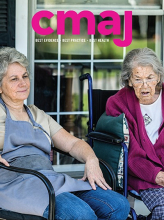The Canadian Society of Palliative Care Physicians would like to comment on Mr. Matthew Herder and Dr. David Juurlink’s proposal that the federal minister of health recall from the Canadian market all high-strength opioid formulations equal to or greater than 100 mg MMEs.1
Although we acknowledge the current opioid crisis and the recently published opioid prescribing guideline that applies to noncancer pain,2 we have serious concerns about this proposed recall in the context of patients with cancer pain and palliative care needs, including those who also suffer from opioid use disorder. The College of Physicians and Surgeons of British Columbia’s practice standard specifically emphasizes that the opioid guideline2 is not intended for such patients.3
Our own position statement (i.e., that of the Canadian Society of Palliative Care Physicians) on access to opioids for patients requiring palliative care4 and the World Health Organization’s report on cancer pain relief5 recommend the use of opioids for cancer pain at doses that are titrated up to effect and tolerability, with no maximum dose. We are currently producing Opioid Wisely guidelines for Choosing Wisely Canada on opioid prescribing.
Patients with cancer pain sometimes require large doses of opioids to control their pain, even well above 200 mg oral morphine equivalent.6 Patients with concurrent opioid use disorder and cancer pain are often given, in addition to opioid agonist therapy, a long-acting oral dose once daily or transdermal opioid preparations,7 often at high doses because of opioid tolerance, following careful risk assessment and management.7
Limiting the availability of high-strength opioid formulations could create difficulties and barriers for patients with cancer pain and other palliative needs. Having to take multiple doses of a lower-strength preparation in the context of complex drug regimens for cancer could increase the risk of errors and poor adherence. This could also create a barrier to obtaining prescriptions from family doctors who are already cautious about prescribing opioids in large quantities.
For patients with palliative care needs who also have opioid use disorder, and need high-strength additional opioids for pain, it is safer to prescribe a single large once-daily supervised oral ingestion or transdermal application rather than multiple lower-dose preparations spread throughout the day.8 Restricting access to products that enable this practice will increase rather than decrease the risk of diversion. The use of multiple lower-dose transdermal patches could enable diversion, as the patient may be able to tolerate a small decrease in dose while some of the patches are diverted.
Ontario’s Palliative Care Facilitated Access program offers a possible solution.9 As of 2016, prescribing of high-strength opioid formulations is restricted to a prescriber or contact with a prescriber registered by the licensing body as a palliative care physician. This has reduced prescriptions for these formulations while maintaining access for those who need them for palliative care. All practitioners need to continue to work together to ensure the health care needs of all patients are met.
Footnotes
Competing interests: None declared.











